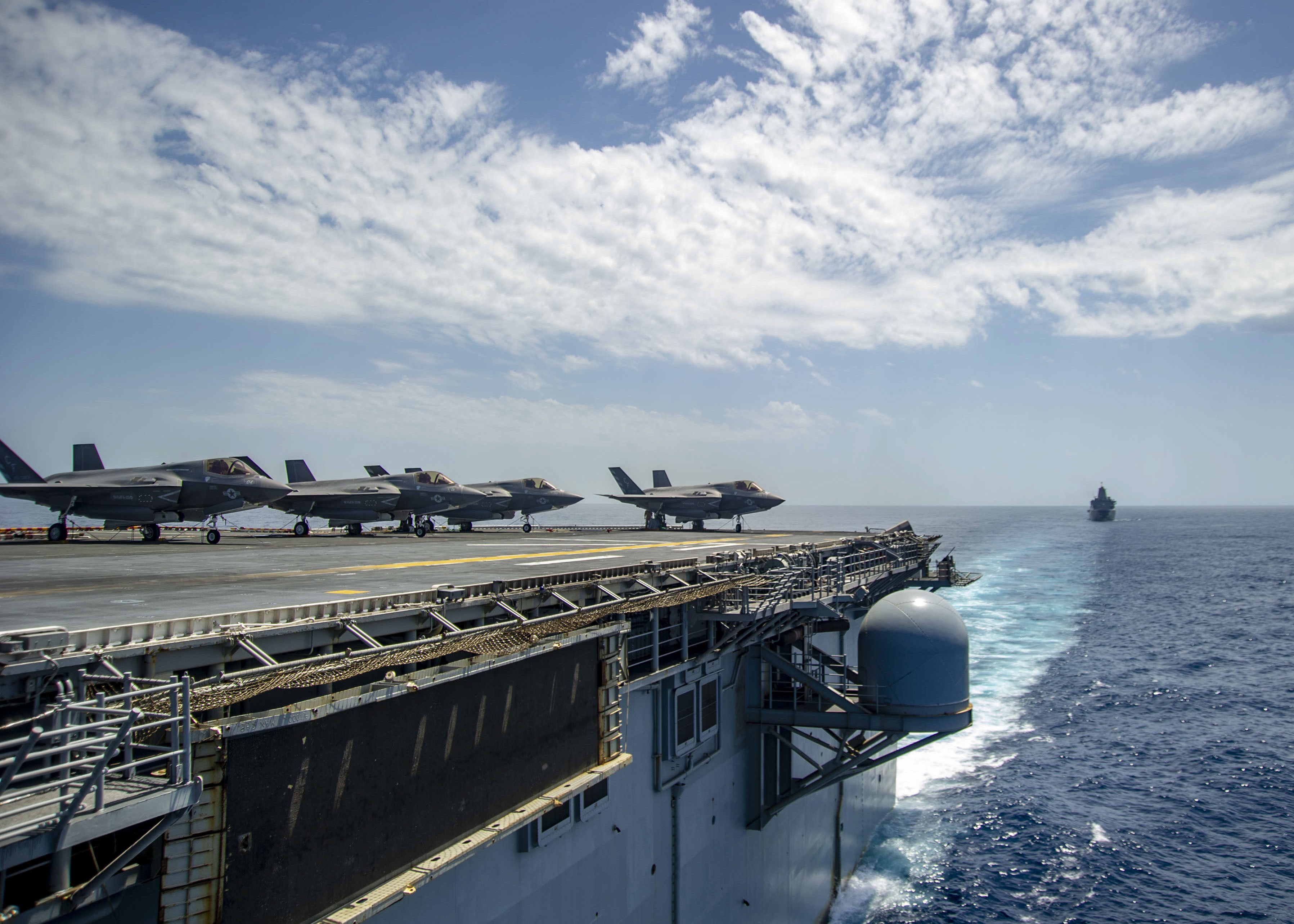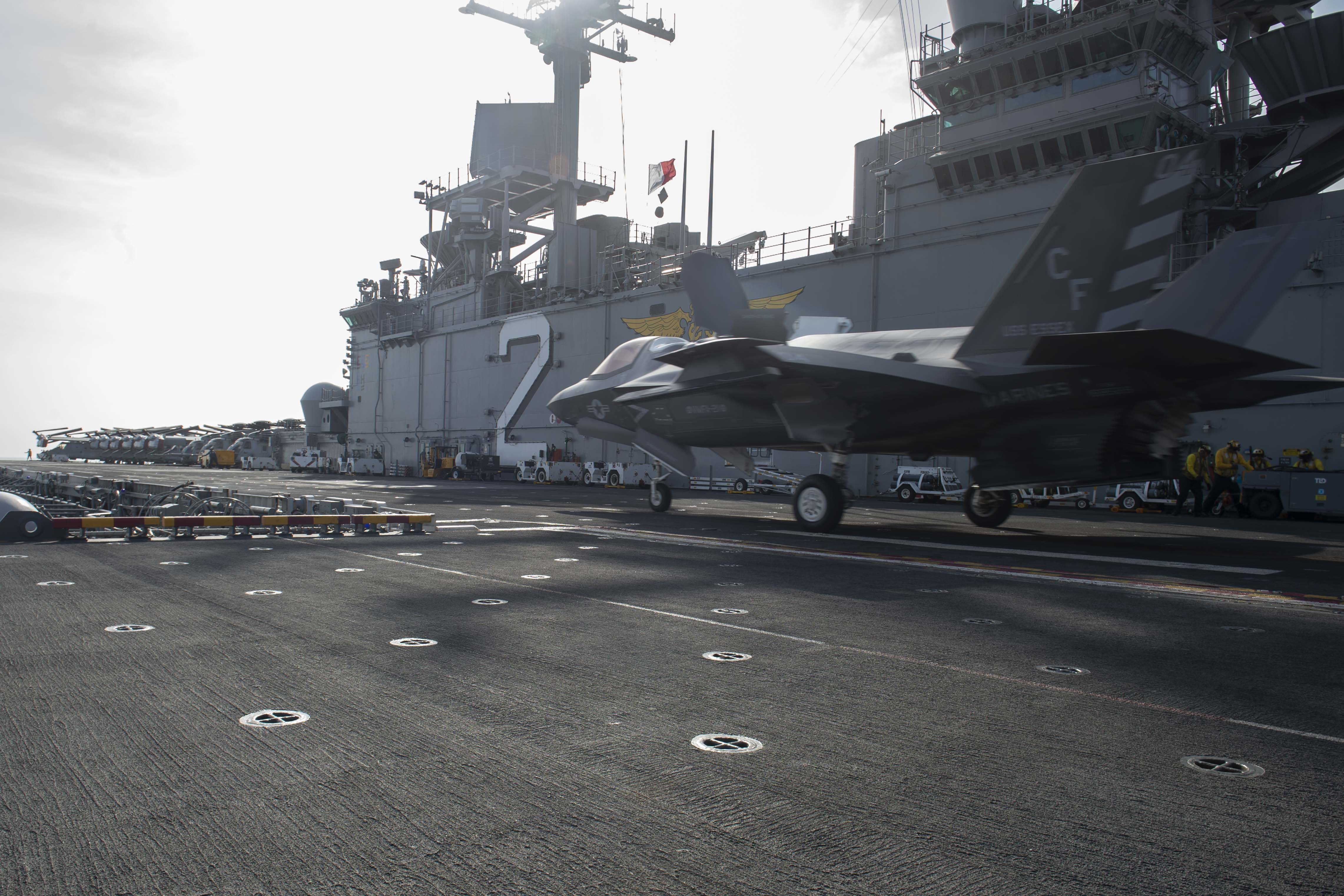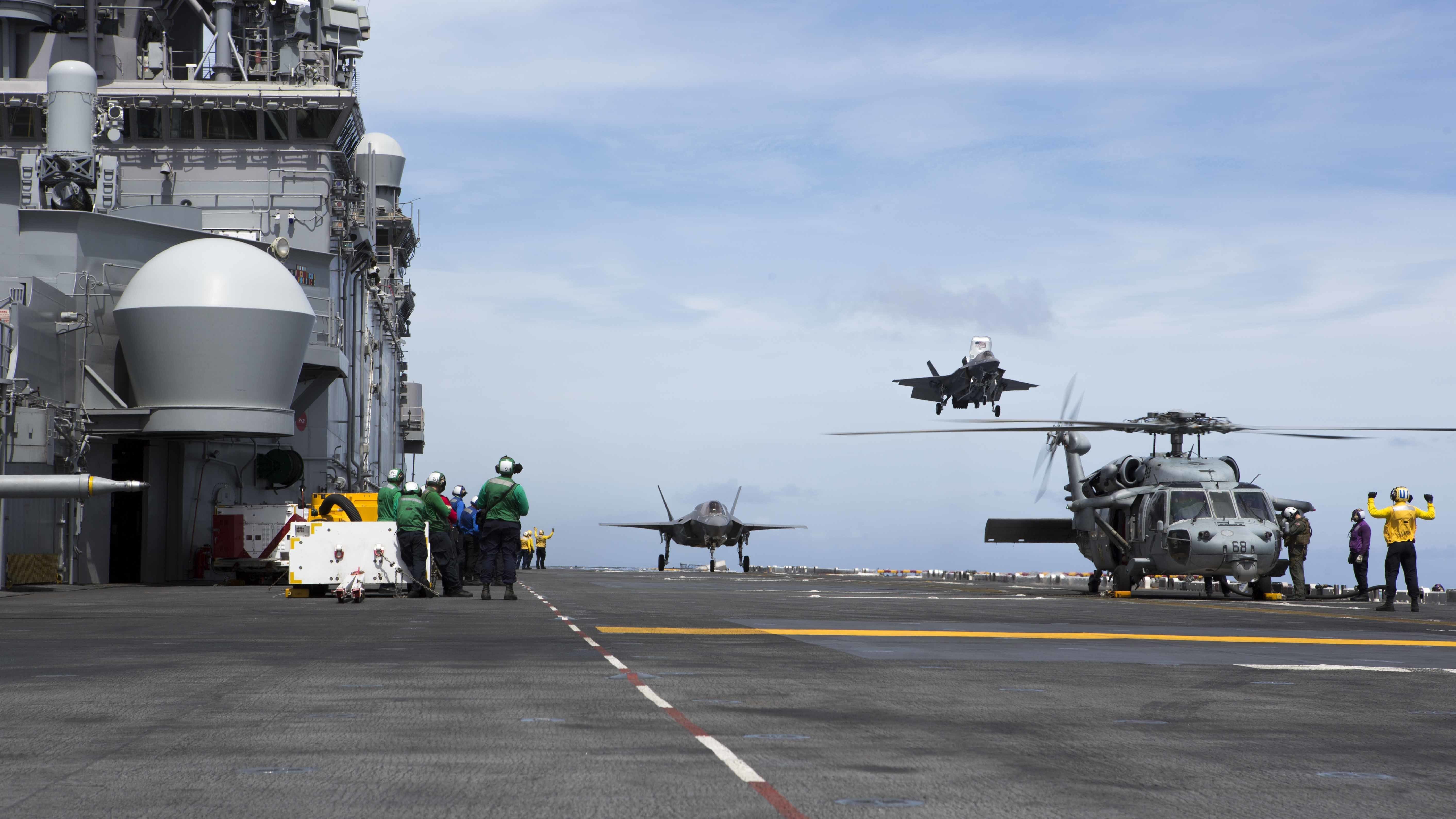
F-35B Lightning II, attached to the “Avengers” of Marine Fighter Attack Squadron (VMFA) 211, sit on the flight deck of Wasp-class amphibious assault ship USS Essex (LHD 2) on Sept. 4, 2018, while transiting the Indian Ocean with San Antonio-class amphibious transport dock USS Anchorage (LPD 23) during a regularly scheduled deployment of Essex Amphibious Ready Group (ARG) and 13th Marine Expeditionary Unit (MEU). The Essex ARG and 13th MEU is the first U.S. Navy/Marine Corps team to deploy to U.S. 5th Fleet area of operations with the F-35B Lightning II. US Navy photo.
The Marine Corps’ F-35B Lightning II Joint Strike Fighters are the only ship-based fixed-wing aircraft in the Middle East right now, and service leaders say the new jets are ready to handle any fight in Syria, Iraq or Afghanistan they may be tasked with.
Though the F-35Bs have never seen combat before, they are now the only available fighters from the Navy or Marine Corps in the region, and service leaders say they are not going to ease the F-35 into operations. Whatever 5th Fleet and U.S. Central Command leadership asks of naval aviation, the F-35Bs deployed with the Essex Amphibious Ready Group and 13th Marine Expeditionary Unit will be ready to handle, they say.
“The deployment of the F-35B into U.S. Central Command is a major milestone for the program and validates the aircraft is in the fight right now, conducting real-world operations; it is actively supporting combatant commanders. We look forward to demonstrating the capability of our newest, advanced stealth aircraft during this deployment,” Capt. Christopher Harrison, a spokesman at Headquarters Marine Corps at the Pentagon, told USNI News.
“The F-35Bs on the 13th MEU are able to execute any mission that may arise in U.S. Central Command while simultaneously providing a high-end deterrent to any near-peer threat that may emerge. These aircraft feature Block 3F software which provides ‘full warfighting capability’ from its fully-enabled data link to increased weapons delivery capacity. The F-35’s ability to operate in contested areas, including anti-access/area-denial environments that legacy fighters cannot penetrate, provides more lethality and flexibility to the combatant commander than any other fighter platform.”
USNI News previously reported the Block 3F software allows the plane to load up with more ordnance than the F/A-18C Hornet can carry through external pylons, or it can clear the wings and rely only on internal weapons carriage to preserve its fifth-generation stealth capability.

An F-35B Lightning II, attached to the “Avengers” of Marine Fighter Attack Squadron (VMFA) 211, launches from the flight deck of Wasp-class amphibious assault ship USS Essex (LHD 2) on Sept. 2, 2018, during a regularly scheduled deployment of Essex Amphibious Ready Group (ARG) and 13th Marine Expeditionary Unit (MEU). US Navy photo.
Whereas the U.S. military faced relatively uncontested air space over Afghanistan and Iraq for the better part of the last 17 years, the fight over Syria is much more complex. The Syrian government has its own jets in the air and air defense systems on the ground. Russian forces and other players complicate the air space, as the U.S. has tried to provide close-air support for U.S. and partner forces on the ground.
Lt. Christina Gibson, a spokeswoman for U.S. Naval Forces Central Command, told USNI News that, rather than ease the new F-35Bs into operations, leaders would leverage the advanced capabilities the jets bring to this complex airspace.
“The F-35B Lightning II is a significant advance in air superiority. It combines next-generation fighter characteristics of radar-evading stealth, supersonic speed, fighter agility and advanced logistical support with the most powerful and comprehensive integrated sensor package of any fighter aircraft in history, providing the [Marine Air-Ground Task Force] unparalleled lethality and survivability,” she said.
“The F-35B can provide close air support in threat environments where other current platforms would not survive, or require multiple aircraft packages. It provides unparalleled protection to our Marines and Sailors on the ground.”
Gibson added that the new plane provides more options to operational planners by being able to get into spaces that legacy F/A-18 Hornets and Super Hornets and AV-8B Harriers couldn’t, and “allows pilots and the MEU commander to do more to protect our warfighters and coalition partners on the ground. The F-35B allows us to approach our mission from a position of strength in the CENTCOM [area of responsibility], enabling maritime superiority that enhances stability and ensures security while providing support to operations on the ground.”

An F-35B Lightning II from Marine Fighter Attack Squadron 211, 13th Marine Expeditionary Unit (MEU), lands aboard the Wasp-class amphibious assault ship USS Essex (LHD 2), during a regularly scheduled deployment of the Essex Amphibious Ready Group (ARG) and the 13th MEU, July 24, 2018. US Marine Corps photo.
The Essex ARG and 13th MEU chopped into U.S. 5th Fleet at the beginning of September – during a time when no capital ships at all have been in the region to provide strike aviation to Operation Inherent Resolve or Operation Freedom’s Sentinel since the Iwo Jima ARG chopped out of 5th Fleet in mid-July. No aircraft carriers have been in the region since USS Harry S. Truman (CVN-75) stopped conducting strikes against the Islamic State from the Mediterranean in mid-June, and no carriers have operated from within the 5th Fleet area of responsibility since USS Theodore Roosevelt (CVN-71) sailed from 5th Fleet into 7th Fleet in late March.
During this amphibious force’s time in 5th Fleet, the Essex ARG and 13th MEU will do what most other ARG/MEUs do during their deployments: they will train with partners’ militaries, they will conduct sustainment training, and they will be ready to respond to crises that arise, as well as support the named operations in the Middle East if called upon. The presence of the F-35s doesn’t change any of that, Gibson said, but she added that leaders were excited to show off the new capability and approach each task with a more sophisticated weapon.
“The ARG/MEU team will participate in exercises and, as tasked, combat operations during their deployment in the U.S. 5th Fleet area of operations. From these exercises and operations, the Navy/Marine Corps team will demonstrate the capabilities that the F-35B brings to the ARG/MEU and how to best employ those capabilities,” she said.
“The Essex Amphibious Ready Group and the 13th Marine Corps Expeditionary Unit are conducting a Theater Amphibious Combat Rehearsal to demonstrate the ability to secure littoral environments, as part of the Theater Counter Mine and Maritime Security Exercise. Commencing September 8th, the U.S. 5th Fleet is leading four exercises across the theater with regional and global partners which demonstrate our capability, intent, and resolve to ensure freedom of movement and navigation through all three critical choke points across the theater simultaneously. The F-35B allows the ARG/MEU to demonstrate resolve to provide air and maritime superiority to ensure security at sea and on land with the introduction of the world’s most advanced fighter aircraft. The F-35B allows us to approach our mission from a position of strength in the Central Region and to ensure freedom of movement and navigation through all three critical choke points across the theater simultaneously.”
